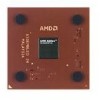AMD AX2000DMT3C User Guide - Page 82
FID[3:0] Pins, FID[3] Y3, and FID[0] W1 are
 |
View all AMD AX2000DMT3C manuals
Add to My Manuals
Save this manual to your list of manuals |
Page 82 highlights
Preliminary Information AMD Athlon™ XP Processor Model 6 Data Sheet 24309E-March 2002 FID[3:0] Pins FID[3] (Y3), FID[2] (Y1), FID[1] (W3), and FID[0] (W1) are the 4-bit processor clock-to-SYSCLK ratio. Table 21 describes the encodings of the clock multipliers on FID[3:0]. Table 21. FID[3:0] Clock Multiplier Encodings FID[3:0]2 Processor Clock to SYSCLK Frequency Ratio 0000 11 0001 11.5 0010 12 0011 ≥ 12.51 0100 5 0101 5.5 0110 6 0111 6.5 1000 7 1001 7.5 1010 8 1011 8.5 1100 9 1101 9.5 1110 10 1111 10.5 Notes: 1. All ratios greater than or equal to 12.5x have the same FID[3:0] code of 0011, which causes the SIP configuration for all ratios of 12.5x or greater to be the same. 2. BIOS initializes the CLK_Ctl MSR to 6003_D22Fh during the POST routine. This CLK_Ctl setting is used with all FID combinations and selects a Halt disconnect divisor of 64 and a Stop Grant disconnect divisor of 64. For more information, refer to the AMD Athlon™ and AMD Duron™ Processors BIOS, Software, and Debug Developers Guide, order# 21656. The FID[3:0] signals are open drain processor outputs that are pulled High on the motherboard and sampled by the chipset to determine the SIP (Serialization Initialization Packet) that is sent to the processor. The FID[3:0] signals are valid after PWROK is asserted. The FID[3:0]signals must not be sampled until they become valid. See the AMD Athlon™ and AMD Duron™ System Bus Specification, order# 21902 for more information about Serialization Initialization Packets and SIP protocol. 70 Pin Descriptions Chapter 10















